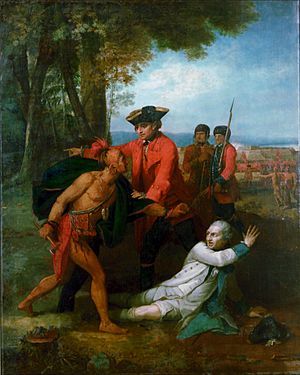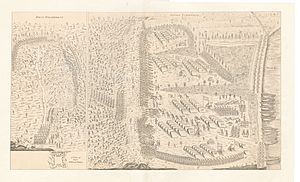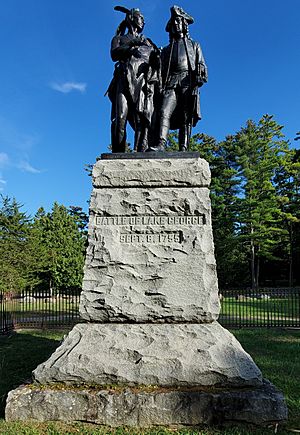Battle of Lake George facts for kids
Quick facts for kids Battle of Lake George |
|||||||
|---|---|---|---|---|---|---|---|
| Part of the French and Indian War | |||||||
 Benjamin West's depiction of William Johnson sparing Baron Dieskau's life after the battle |
|||||||
|
|||||||
| Belligerents | |||||||
|
|||||||
| Commanders and leaders | |||||||
| William Johnson William Eyre Hendrick Theyanoguin † Ephraim Williams † Phineas Lyman |
Jean Erdman, Baron Dieskau (POW) Jacques Legardeur de Saint-Pierre † |
||||||
| Strength | |||||||
| 1,500 Provincial troops 200 Mohawk Warriors |
1,500 regulars, militia, and natives |
||||||
| Casualties and losses | |||||||
| 331 total ? Disputed (see 'Losses') | 339 total ? Disputed (see 'Losses') | ||||||
The Battle of Lake George was a major fight during the French and Indian War. It happened on September 8, 1755, in what is now New York. This battle was part of a bigger plan by the British to push the French out of North America.
On one side, about 1,500 French, Canadian, and Indigenous soldiers fought. They were led by a French commander named Baron de Dieskau. On the other side, there were 1,500 colonial troops. These troops were from the British colonies and were led by William Johnson. Also fighting with Johnson were 200 Mohawk warriors, led by their chief, Hendrick Theyanoguin.
The battle had three main parts. In the end, the British and their allies won. After the fighting, William Johnson decided to build Fort William Henry. This helped the British keep control of the area.
Contents
Why the Battle Happened
William Johnson had just become the British agent for the Iroquois people. On August 28, 1755, he arrived at a lake the French called Lac du Saint Sacrement. Johnson renamed it "Lake George" to honor the British king, George II.
Johnson's plan was to travel along Lake George and Lake Champlain. He wanted to attack Fort St. Frédéric at Crown Point. This French fort was very important for defending New France.
To stop Johnson, Baron Dieskau moved his French forces. He set up camp between Lake George and Lake Champlain. This spot later became Fort Ticonderoga. On September 4, Dieskau decided to attack Johnson's supply base. This base was a new fort called Fort Edward (then known as "Fort Lyman").
Dieskau wanted to destroy the boats, supplies, and cannons Johnson needed. He left half his soldiers at his camp. Dieskau then led 222 French soldiers, 600 Canadian militia, and 700 Abenaki and Caughnawaga Mohawk allies. They marched toward Fort Edward.
Johnson was camped about 14 miles (22 km) north of Fort Edward. His scouts warned him that enemy forces were nearby. Johnson sent a messenger to warn the 500 soldiers at Fort Edward. But the messenger was captured. This meant Dieskau learned where all of Johnson's troops were.
The Indigenous allies with Dieskau did not want to attack Fort Edward. They thought it would have too many cannons. So, Dieskau changed his plan. He ordered his troops to march north toward Lake George.
The Battle Begins
At 9:00 a.m. on September 8, Johnson sent Colonel Ephraim Williams south. Williams had 200 Mohawk allies and 1,000 soldiers. They were going to help Fort Edward.
Dieskau learned about Williams' approach from a deserter. He quickly set up a trap. His French soldiers blocked the main road. His Canadians and Indigenous allies hid on both sides of the road. They waited in a ravine about three miles south of the current village of Lake George.
The "Bloody Morning Scout"
Williams' column marched right into Dieskau's trap. They were met with a sudden burst of gunfire. This part of the battle became known as the "Bloody Morning Scout." Colonel Williams and Chief Hendrick were both killed. Many of their soldiers also died.
The French soldiers then fired many shots at the colonial troops. Most of the New England soldiers ran back toward Johnson's camp. About 100 soldiers, led by Colonel Nathan Whiting and Lt. Col. Seth Pomeroy, stayed behind. Most of the surviving Mohawks also helped. They fought as they retreated, covering the escape of their comrades.
This rearguard managed to hurt many of the French pursuers. Pomeroy wrote that his men "killed great numbers of them; they were seen to drop like pigeons." One important French leader, Jacques Legardeur de Saint-Pierre, was killed. He was the commander of Dieskau's Canadian and Indigenous forces. His death greatly upset the French Indigenous allies.
Attack on Johnson's Camp
Dieskau wanted his Canadians and Indigenous allies to follow the fleeing British. He ordered them to attack Johnson's camp. But the Caughnawaga Mohawks were already discouraged by their leader's death. They did not want to attack a camp that was dug in and defended. They knew many of their Mohawk relatives were fighting for the British inside the camp. The Abenakis and Canadians also refused to go forward without the Caughnawagas.
Hoping to make them attack, Dieskau led his 222 French soldiers himself. They marched in a column toward Johnson's camp. Johnson had quickly built defenses around his camp. He used wagons, overturned boats, and cut-down trees.
Once the French soldiers were in the open, the British cannons fired. They used grapeshot, which is like many small cannonballs. This created "lanes, streets and alleys" through the French lines. Johnson was wounded and had to leave the fight. General Phineas Lyman took over command. Dieskau was also badly wounded, and the French attack stopped.
After the French left, the British found about 20 badly wounded French soldiers. They were too close to the British cannons for their friends to rescue them. Baron Dieskau was among them, shot through the bladder. A famous painting by Benjamin West shows Johnson saving a French officer, believed to be Baron Dieskau.
Bloody Pond
Meanwhile, Colonel Joseph Blanchard was at Fort Edward. He saw smoke from the battle in the distance. He sent out 80 soldiers from New Hampshire and 40 from New York. They were led by Captain Nathaniel Folsom and Captain McGennis.
They heard the sounds of the battle and moved quickly. About two miles from the lake, they found the French army's supplies. These supplies were guarded. Folsom's men attacked and scattered the guards. Around four in the afternoon, about 300 French soldiers appeared. They were retreating but in some order.
Captain Folsom had his men hide among the trees. As the enemy came closer, they fired at them. Folsom's men kept attacking until it got dark. They killed many of the enemy and took some prisoners. They also took many of the enemy's packs. Folsom then brought his wounded, prisoners, and supplies safely back to camp. The next day, the rest of the French supplies were brought in.
In this fight, Folsom lost only six men. Captain McGennis was badly wounded and died soon after. The French lost many soldiers. The bodies of the French and Indigenous soldiers killed here were thrown into a pond. To this day, it is called "Bloody Pond."
What Happened Next
The Battle of Lake George, fought in three parts, ended with a British victory. Johnson's army did not reach Fort St. Frédéric. However, the outcome at Lake George was very important. Johnson was able to move far down the lake. He then built Fort William Henry at the southern end of the lake. This helped the British control the area.
Historian Fred Anderson wrote that if Dieskau had stopped Johnson at Fort Edward, it would have been a big problem for the British. It would have ended the threat to Fort St. Frédéric. It also would have pushed back the defenses of New York and New England all the way to Albany.
Counting the Losses
It is hard to know the exact number of soldiers lost in the Battle of Lake George. Different reports give different numbers.
A letter from October 20, 1755, from a French officer named Monsieur Doreil, gives some details. It says that the French soldiers who attacked Johnson's camp lost more than a third of their men. The Regiment de la Reine had 21 killed or missing and 30 wounded. The Regiment de Languedoc had 5 killed and 21 wounded.
Peter Palmer, a historian, wrote that the British lost about 216 killed and 96 wounded. He said the French losses were much higher. He claimed Johnson thought the French lost 500 to 600 men. Another source said it was almost 800.
W. Max Reid stated that the British lost 262 killed, wounded, and missing. He said the French lost 228, according to their own records.
Ian K. Steele, another historian, looked at the British losses. He said the official numbers were 154 dead, 103 wounded, and 67 missing. Most of those missing were later found dead. He added that the Iroquois (Indigenous) casualties brought the total to 223 dead and about 108 wounded.
For the French losses, Steele said the official French report listed 149 dead, 163 wounded, and 27 captured. He noted that the total numbers of killed, wounded, and captured were very similar for both sides. The British lost 331, and the French lost 339. Steele thought the number of Indigenous casualties might have been reported as lower than it actually was.
In his 2009 book, Combattre pour la France en Amérique, Marcel Fournier gives different numbers. He reported 800 killed or wounded for the British. He stated 200 killed or wounded for the French.
Images for kids
See also
 In Spanish: Batalla de Lake George para niños
In Spanish: Batalla de Lake George para niños








